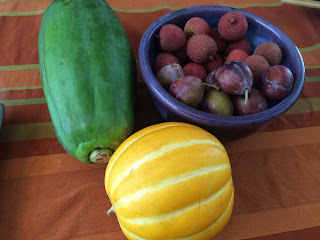Some of our out of town friends were visiting and wanted to see how sausage is made. Having successfully made sausage a few times, we decided to up the ante, with fresh Mexican chorizo and dried Spanish chorizo.
For the Mexican chorizo, we started with the recipe at honestcooking.com. What did we lab? The vinegar: cider versus white wine versus red wine versus sherry. Of course, Mexican chorizo is also intended to be fresh sausage style, so we didn't stuff it in casings. When we fried up the patties, we discovered that structural integrity was an issue (the pork shoulder we got from the McLean Organic Butcher may have been higher fat than the recipe stipulated).
You might think that the sherry would be the winner, and that's actually what The Executive Committee preferred, although the rest of us preferred red wine vinegar. We also pretty quickly realized that we needed to up the red pepper flakes. And we'd forgotten the garlic in the test batch. Oops! We corrected that in the full batches, which we made with red wine vinegar and a Tbsp of crushed red pepper flakes for each pound of meat.
But that wasn't the real test - the real test was making Spanish style chorizo. We started with the same base recipe, but divided the paprika between sweet and smoked, added cayenne, used sherry vinegar, and DOUBLED the salt.
And then we stuffed them.
And then Mad Kitchen Scientist and The Executive Committee hung them to cure in their basement for about two months. Yes, really. Raw meat.
When they were finally ready, we decided that we'd have to try eating them together. If we were going to go down to food poisoning and/or botulism, we were going as a group. So we gathered this weekend for an evening of eating raw meat we'd dry cured ourselves, making paella, and planning our upcoming foodie trip to Italy this fall (more about that in a future post).
The first thing we did was slice up one of the sausages and eat it. And we all survived! And it was DELICIOUS.
When none of us had dropped over dead immediately, we celebrated with white peach sangria, paella, and flan.
The sangria was very loosely based on this recipe, although I reduced the pineapple juice by about half, and the simple syrup by about 3/4. I was using berries and mango as the additional fruit, rather than apples and pears, and I thought it would be too sweet otherwise. And instead of goosing it with brandy, I used anjeo tequila. When I served it, I topped it with a little champagne, since I think white sangria benefits from bubbles.
The paella was loosely based on this recipe. We substituted chicken for the rabbit, mostly because we had a chicken and were too lazy to go over to Eastern Market for a rabbit. We didn't like the idea of using green beans, so we used some gorgeous red and green poblano peppers I had from the CSA, and we used far more than a "pinch" of saffron. It was also delicious, but it makes A LOT. We were each left with two quarter containers of paella leftovers. I know what I'll be having for lunch this week. The method is very similar to making risotto, which is logical when you think about it: force a lot of yummy liquid into a short grain rice, add tasty goodness in the form of meat and/or veg, and eat.
In keeping with the Spanish theme, we decided we needed to make some flan, too, based on this extremely simple recipe. Interestingly, they have you caramelize the sugar without any water. You have to go slow and keep an eye on it, but it got to a lovely dark brown color without any danger of burning, so I have to say that I recommend it. It didn't call for any salt, which I thought was bogus, so I added about a teaspoon. We baked in individual flan cups rather than one big pan, so we did the water bath method even though the recipe doesn't call for it, and cut the cook time back to about 40 minutes. It was probably about 5 minutes too long, or perhaps the specified temperature is a bit too high (Mad Kitchen Scientist said he's usually done flan at 300 rather than 350), so it was a little more firm that ideal, but still quite tasty.
I don't know that I would necessarily recommend attempting to dry age your own sausage to everyone. There is a very real risk of serious illness. If you're going to do it, make sure to use top quality meat, don't be shy with the spices or salt, and watch the sausages carefully as they dry. If anything feels, looks, or smells off, don't hesitate to dump them. That said, life is risk and this one was deliciously worth it.














